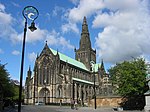Battle of Glasgow (1560)
1560 in ScotlandBattles involving FranceBattles involving ScotlandConflicts in 1560France–Scotland relations ... and 3 more
France–United Kingdom military relationsHistory of GlasgowScottish Reformation
The Battle of Glasgow, 18 March 1560, was fought by supporters of the Scottish Reformation against French troops.
Excerpt from the Wikipedia article Battle of Glasgow (1560) (License: CC BY-SA 3.0, Authors).Battle of Glasgow (1560)
Castle Street, Glasgow Townhead
Geographical coordinates (GPS) Address Website Nearby Places Show on map
Geographical coordinates (GPS)
| Latitude | Longitude |
|---|---|
| N 55.862972222222 ° | E -4.2344444444444 ° |
Address
Glasgow Cathedral (High Kirk of Glasgow;St Kentigern's;St Mungo's Cathedral)
Castle Street
G4 0QZ Glasgow, Townhead
Scotland, United Kingdom
Open on Google Maps










